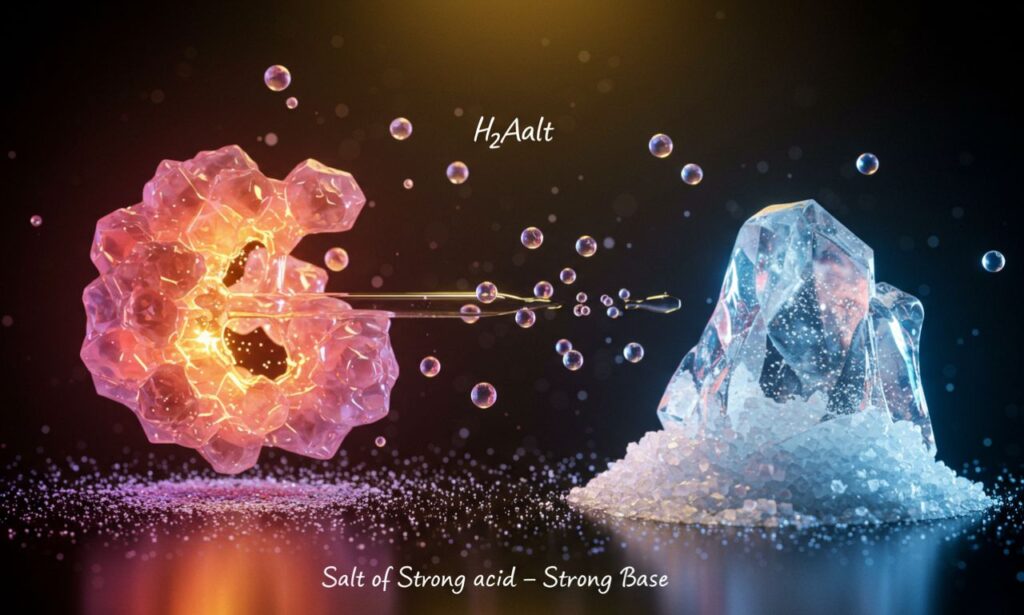The salt of strong acid and strong base is a crucial concept in chemistry, especially when studying acid-base reactions and pH balance. These salts form when a strong acid reacts with a strong base during a neutralization reaction. The resulting salt is typically neutral in nature and plays an important role in various industries, biological systems, and laboratory settings.
Understanding the salt of strong acid and strong base gives insight into fundamental chemical processes and helps predict the outcomes of reactions involving acids and bases.
Defining the Sa lt of Str-ong Acid and Strong Base
In chemistry, a salt is an ionic compound formed when the hydrogen ions (H⁺) of an acid are replaced by metal or ammonium ions from a base. When the acid and base involved are both strong, the reaction results in a neutral salt—one that does not affect the pH of the solution significantly.
Examples:
-
Hydrochloric acid (HCl) + Sodium hydroxide (NaOH) → Sodium chloride (NaCl) + Water
-
Nitric acid (HNO₃) + Potassium hydroxide (KOH) → Potassium nitrate (KNO₃) + Water
In these examples, the salt of strong acid and strong base formed is completely ionized in water and does not hydrolyze.
Characteristics of the Salt of Strong Acid and Strong Base
Salts formed from strong acids and strong bases have several defining characteristics:
-
Neutral pH: Typically close to 7, especially in dilute solutions.
-
Complete Dissociation: The ions fully dissociate in aqueous solution.
-
No Hydrolysis: These salts do not undergo hydrolysis and hence do not affect the pH.
-
High Solubility: Most are soluble in water due to the strong ionic bonds.
These properties make the salt of strong acid and strong base predictable and useful in controlled chemical environments.
Formation of Salt of Strong Acid and Strong Base
Neutralization Reaction
The most straightforward method for forming a salt of str-ong acid and str-ong base is through neutralization:
Acid + Base → Salt + Water
For example:
-
HCl + NaOH → NaCl + H₂O
Here, hydrogen ion (H⁺) from HCl combines with hydroxide ion (OH⁻) from NaOH to form water, and the remaining Na⁺ and Cl⁻ ions form sodium chloride.
Titration Process
In a laboratory setting, titration helps determine the point of complete neutralization. At the equivalence point, the amount of strong acid equals the amount of strong base, resulting in the perfect formation of a neutral salt.
pH of Salt of Strong Acid and Strong Base
The pH of the salt of str-ong acid and str-ong base is typically around 7. This is because:
-
Both the cation (from the base) and the anion (from the acid) are neutral in water.
-
They do not donate or accept hydrogen ions, thus not altering the pH.
-
Example: NaCl, when dissolved in water, does not form H⁺ or OH⁻ ions.
This makes such salts ideal for maintaining neutral conditions in chemical reactions or solutions.
Examples of Common Salts from Strong Acids and Strong Bases
Here are some of the most commonly encountered salts of str-ong acid and str-ong base:
| Acid | Base | Salt Formed |
|---|---|---|
| HCl | NaOH | Sodium chloride (NaCl) |
| HNO₃ | KOH | Potassium nitrate (KNO₃) |
| H₂SO₄ | Ba(OH)₂ | Barium sulfate (BaSO₄) |
| HCl | NH₄OH | Ammonium chloride (NH₄Cl) |
Note: NH₄OH is a weak base, so NH₄Cl is not a true neutral salt; the list helps compare outcomes.
Real-Life Applications of Salt of Strong Acid and Base
1. In Food Industry
-
Sodium chloride (NaCl) is the most widely used salt in cooking and food preservation.
-
It is a classic example of the salt of str-ong acid and str-ong base, offering flavor and acting as a preservative.
2. In Chemical Laboratories
-
Neutral salts are used as buffers in pH control or as standards in titration experiments.
-
They are also employed in precipitation reactions for identifying ions.
3. In Medicine
-
Ringer’s solution and saline water contain sodium chloride, which helps in intravenous therapy.
-
These salts balance electrolytes and maintain osmotic pressure.
4. In Water Softening
-
Some neutral salts are used in ion exchange processes to remove hardness from water.
-
Sodium salts help in replacing calcium and magnesium ions in water treatment.
Differences Between Neutral, Acidic, and Basic Salts
While the salt of strong acid and strong base is neutral, not all salts are. Here’s how they differ:
| Type of Salt | Formed From | pH | Example |
|---|---|---|---|
| Neutral Salt | Strong acid + Strong base | ~7 (Neutral) | NaCl |
| Acidic Salt | Strong acid + Weak base | <7 (Acidic) | NH₄Cl |
| Basic Salt | Weak acid + Strong base | >7 (Basic) | Na₂CO₃ |
Understanding this helps avoid confusion when dealing with reactions that produce various salt types.
Laboratory Identification of Salt of Strong Acid and Strong Base
1. Flame Test
-
Certain metal salts (like Na⁺ or K⁺) show characteristic flame colors.
-
Sodium gives a bright yellow flame, while potassium shows violet.
2. pH Test
-
Using litmus paper or pH meters, a neutral salt will show a pH of around 7.
3. Solubility Test
-
Most salts from stro-ng acid and base combinations are highly soluble in water.
4. Ion Detection
-
Using reagents like silver nitrate or barium chloride, one can detect the specific ions (like Cl⁻ or SO₄²⁻) in the salt.
Environmental and Biological Role of Neutral Salts
1. Soil and Plant Health
-
Neutral salts help maintain soil pH for plant growth.
-
Excessive salts, however, can cause soil salinization, harming crops.
2. Human Body Functions
-
Salts like NaCl maintain electrolyte balance and nerve function.
-
They also play roles in blood pressure regulation and muscle contraction.
Important Considerations in Handling and Storage
While most sa lts of stro ng acid and strong base are safe, they should still be handled with care:
-
Store in dry conditions, to avoid clumping or degradation.
-
Label clearly, especially in lab environments.
-
Avoid contamination, by using clean tools and containers.
Conclusion: Why the Salt of Strong Acid and Strong Base Matters
The sa-lt of stro ng acid and stro-ng base is more than just a lab curiosity—it’s central to many real-world processes. From maintaining our body’s electrolyte balance to preserving food and supporting industrial reactions, these salts serve a broad and essential function. Their neutral nature and predictable behavior make them a staple in both classrooms and professional laboratories.
Understanding these salts not only strengthens foundational chemistry knowledge but also opens the door to grasping more advanced topics like buffer systems, titration analysis, and ionic equilibrium.







